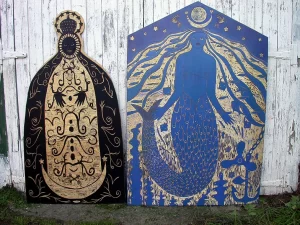Imna Arroyo: Immersed in Yemaya and Iroko Water and Life
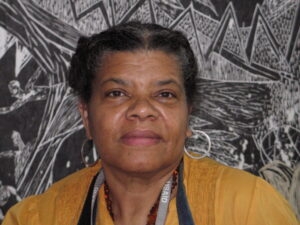
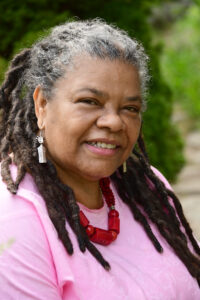
Imna Arroyo’s work, taken as a whole, creates a puzzle of intersecting chronologies, which appear to form the subjective representation of an aesthetic philosophy that reaches toward celestial planes. Humberto Figueroa Iroko, Tree of Life, p. 56
Imna Arroyo bridges art and spirituality in a deeply personal and effective art. She embraces several large themes in her work, that she rethinks and alters each time she creates an installation. Thse two portraits capture two sides of Imna Arroyo, her connection to art and her connection to nature.
Of African, Taino and Spanish heritage, Imna Arroyo is an Afro-Puerto Rican artist deeply committed to acknowledging her multiple heritages and to transforming that heritage into a contemporary artistic statement. Throughout her career she has consistently reached beyond her current work to the next level of creativity, complexity and technical proficiency. She has never settled for a formulaic answer, a single concept, or even a single media. As a result she tells a layered story of her life that resonates with history, place and spirituality. She frequently turns to the symbolism and language of Yoruba poetry, proverbs, legends, myths and imagery.
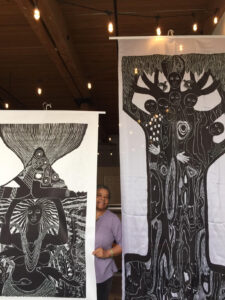
As an artist printmaker Arroyo has had an exceptionally rich training, as she constantly explores new techniques.
As a young woman in the 1960s she studied with José Alicea in Puerto Rico. After coming to the United States , she earned a BFA from Pratt Institute in 1977 studying with Michael Ponce de Leon and Robert Blackburn. Only two years later she completed an MFA at Yale University. With Gabor Peterdi and Winifred Lutz and later Krishna Reddy she further explored etching, aquatint, and color intaglio techniques. In the ’80s Arroyo moved onto mixed media, multi-color Japanese traditional woodcut techniques with Francisco Patlán in Mexico, and aluminum plate printing at Tamarind Institute.
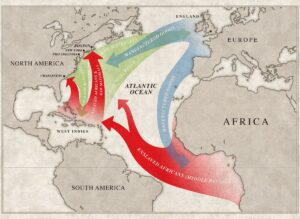

Part I
The Middle Passage
Starting in the late 1500s more than 12 million Africans were transported as slaves from Africa to the Caribbean, then sold for sugar and other raw materials to take back to Europe. The horror of this crime is so great that we are all still processing what it means.
Many artists of African descent address this topic from different perspectives.
Imna Arroyo’s major installation Ancestors of the Passage focuses on those who did not make it through the three week voyage in unspeakable conditions
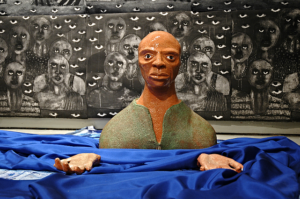
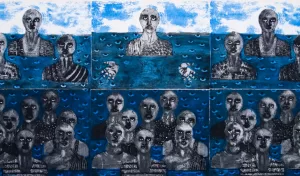
Those who were sick or died were simply thrown overboard. Ancestors emphasizes the spirits of those who died, making them visible in prints and sculptures. She speaks to the presence in the lives of those who survived in memories and cultural practices that came to this country.
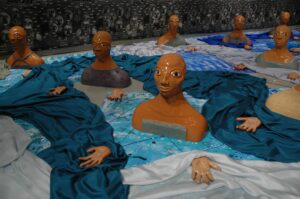
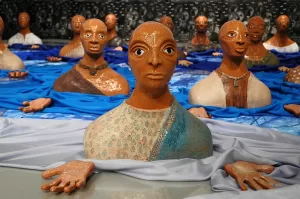
Ancestors of the Passage overwhelms and embraces us with its striking blue sea on the floor, the ceramic busts and hands of those lost in the sea, and a series of prints that cover the walls with haunted faces.
As the artist describes it
Ancestors of the Passage: A Healing Journey Through the Middle Passage is composed of twenty-seven life size terracotta ceramic figures each extending their (54) hands reaching out to the audience. The figures are in a sea of acrylic canvases and blue and green silk fabric, surrounded by (60) black and white collagraphs representing a multitude of people witnessing the journey. The terracotta figures depict the African ancestors that died and are coming back to tell us to remember our gifts. This artwork attempts to gives a visual voice to the untold story of the millions of people who died during the Atlantic crossing.
Arroyo’s awakening and exploration to this horrendous act came when she visited the Door of No Return in Ghana:
In 1997 I traveled for the first time to Ghana. It was at the Elmina Castle, standing in front of the Door of No Return that I had an epiphany that we are all part of a spirit continuum. It was an experience that made me aware of the ancestral realm and forever changed my perception of time and space.
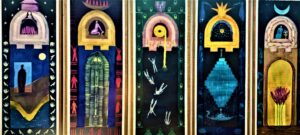
In 1999 she created a series of watercolor paintings called Prelude to the Door of No Return with doorways evoking the shape of the original Door of No Return in Ghana. The artist filled the space of each door and the space around it with references to the Middle Passage, bodies, hands, slaves packed into ships. We can see the roots of the larger Ancestors installation in these abbreviated references.
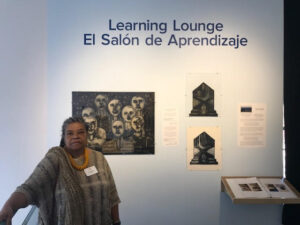
The Prelude to the Door of No Return was reinstalled in “After Spirituality” at the Fitchburg Art Museum from February to September 2020, at the height of the pandemic. It was paired with an altar with a segment of the Ancestors installation to honor those who died in the Middle Passage as well as in the pandemic.
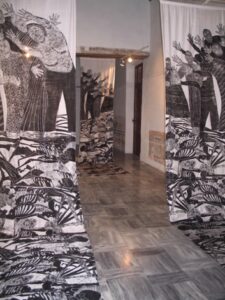
Trail of Bones
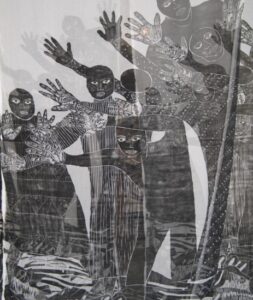
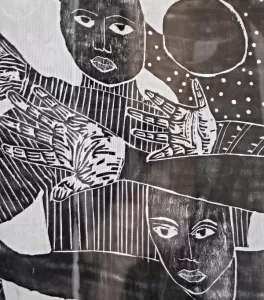
Arroyo has another moving installation referring to death in the Middle Passage, Trail of Bones, an immersive experience in which floor to ceiling black and white prints hover over us. We experience the spirits of those who died and those who survived. A moving video of Trail of Bones appears on her website.
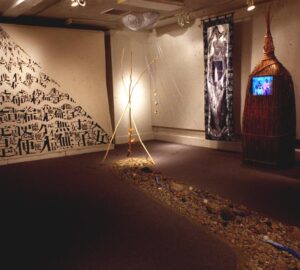
Voices of Water Installation with streambed by Arroyo
Arroyo began exploring Yemaya, Goddess of Water, as a theme in her work in the summer of 2001. It is a logical step from exploring those who drowned in the sea during the Middle Passage to invoking a spiritual presence that both looked over them and looked out for the survivors.
The video The Many Faces of Yemaya first appeared in 2001 in an exhibition “The Voices of Water” in Oregon and the Czech Republic, a collaboration among several artists including Native artist Gail Tremblay.
The video was the partner to an eight-foot-high expressionist woodcut of the sea goddess, the archetypal great mother, printed on satin (visible on the right in the image). The video and the woodcut invoke the seven avatars of this divinity. Yemaya is a deity of orisha worship that originated in Nigeria and later came to the Caribbean and the Americas.
“Voices of Water” was a crucial turning point for the artist in both multimedia and interdisciplinary collaborations, which is still a central part of her work. Her interest in Yemaya has expanded in many directions.
Initially the artist explored the meaning of Yemaya in books such as Yemaya y Oshun , Kariocha, Iyalorichas y Olorichas by Cuban anthropologist Lydia Cabrera. Then she herself engaged with the spiritual practice. In the summer of 2005 Imna Arroyo was initiated into the Lukumi tradition in Cuba.
She received the honorary title of Chief Imna Arroyo/Chief Yeye Agboola of Ido Osun, (Chief Mother of the Garden of Honor) conferred by his Royal Majesty Aderemi Adeen Adeniyi-Adedapo, Ido-Osun, Nigeria, West Africa the morning of his 50th birthday in 2007.
The House of Yemaya woodcuts are printed on fabric framed with Batik cloth. Yemaya is depicted as a mermaid on the inside and the Virgin of Mercy on the outside referencing secret relationship between the African and Catholic religion practices in Cuba.
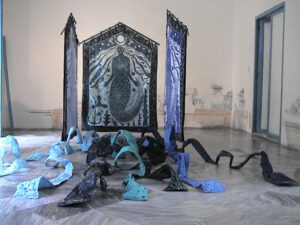
House of Yemaya installation
The Many Paths of Yemaya is a multi-media installation composed of seven panels 2’x 8’ woodblock prints and floor installation recreating the Atlantic and the Caribbean oceans made of fabric batiked by the artist accompanied by handmade paper sculptures, shells, glass, wood sculptures. The panels are printed on Satin and framed with Batik fabric from Ghana, West Africa. A six-minute video is also part of the artwork.
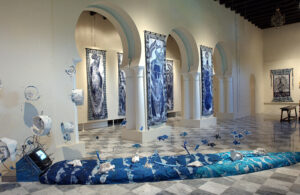
The Many Paths of Yemaya 2000-01
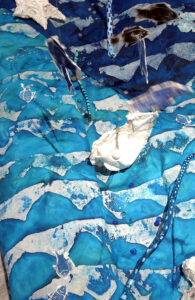
Yemaya floats in midair in the installation Legacy: Ancestral Thread Series:
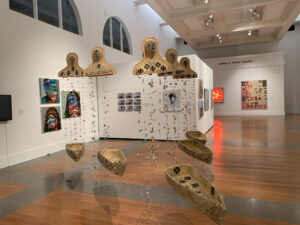
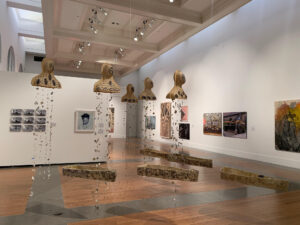
Arroyo describes it:
The installation is composed of five African Orishas or Deities that served as guardians to the ancestors while they were crossing the Middle Passage: Trans Atlantic slave trade. Those who survived the journey brought their multitude of memories from the homeland. My work attempts to re-capture these memory fragments of the Diaspora, weaving together the legacy.
We see the five Orisha busts, three males Elegua, Obatala & Shango and two females, Oshun and Yemaya, made of wire mesh, abaca fiber, hand-made cast cotton pulp suspended in mid air, as memories suggested by small pieces of cotton pulp flow from them down to the floor. Underneath are boats of the same materials.
This work suggests survival, even rejuvenation, through memory and spiritual searching. In some installations the sculptures pair with prints depicting The Journey, small boats with figures, protected or sometime carried by an image of a goddess.
The artist reinstalled Legacies in 2020 in the Coral Gables Museum in the exhibition “Alien2020nation” from December 2020 to March 2021
The catastrophe of the slave trade, the Middle Passage and the protection of the Orishas for those who survived and brought memories of their culture with them, brings us directly to the ongoing tragedies of our contemporary world.
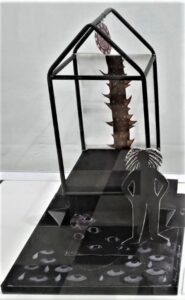
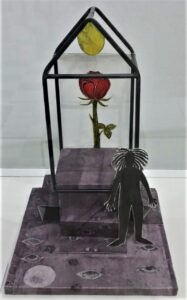
A recently completed diptych, Thorns and Roses a message from the ancestors speaks of our last two years. Two small house-like structures stand on collagraph prints filled with the eyes, perhaps of those drowned in the Middle Passage, or those of more recent tragedies) In one house a thorny stem invokes the pain of life, in the other a rose represents the gifts or blessings discovered throughout these past seven months of COVID-isolation. It appeared in the exhibition A isla miento (Isolation), November 2020 shown in San Juan Puerto Rico, an invitation to artists to address the pandemic. Outside each house stands a cut out women, the artist.
As she explained:
we can choose in our isolation to be safe inside or to feel freedom, to be sad or to be angry.
In the midst of the quarantine, we witnessed the public lynching of Mr. George Floyd, even as more young black bodies were killed by police violence. We continue to see displays of white supremacy, people without the sheets or burning crosses gathering in the streets.
Experiences that seem way too common for the African ancestors who endured violence perpetrated against their black bodies for generations stretching over 400 years. Here, experiences emanating from hate, supremacy, exploitation, greed and inhumanity are the thorns. While the strength and genius of the people are inherent gifts bestowed by the ancestors to navigate uncertainty and overcome adversity, here is the rose.
PART II IROKO TREE OF LIFE
At the same time as these works pairing the Middle Passage with the Orishas, Imna created a series based on “Iroko, Tree of Life.” It culminated in a multimedia collaborative exhibition in 2017, and it is still going through new iterations. The 2017 exhibition included prints of the Ceiba, Tree of Life that depicted its transformation in various cultures.
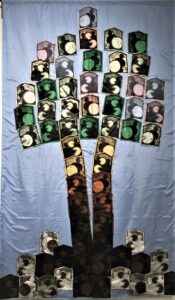
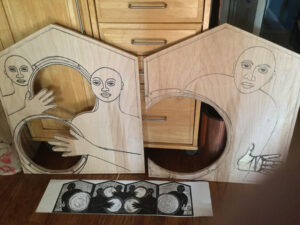
Humberto Figueroa, the curator, describes the installation
“The Iroko installation draws us into a dense thicket of vines that
multiply through the effects of their shadows. Among the twisted
branches, we can make out the silhouettes of simple pitched-roof
houses, typical of the working-class and poorer households of
the Caribbean. The houses in this installation represent the axes
for the divine forces from the Yoruba religion. The deities called
Orishas are represented in the Iroko, and these framed spaces
are meant to signify presences that are intangible and invisible
to the naked eye. The installation extends upward with the
incorporation of numerous other houses in which we see open
palms suggesting supplications to the celestial plane or invocations
to ancestors whose remains reside beyond the horizon. The tree
trunk is suggested by a clustering of houses peopled by inquisitive
eyes and other hands containing faces.
At the foot of the tree, representations of the Orishas can be seen on the floor. The general harmony achieved between the balance of materials and the techniques of engraving and sculpture in an evocative spatial arrangement instills a sense of serenity that is also conducive to multiple interpretations. The Iroko installation is a comprehensive visual text inspired by spiritual expressions filtered through time, other cultures and contexts.”
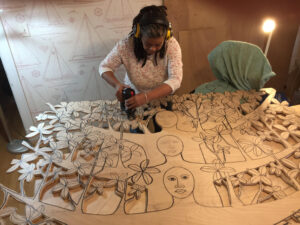
working on the plywood plate of Yoruba Gaze
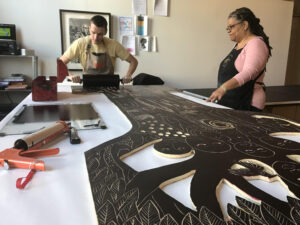
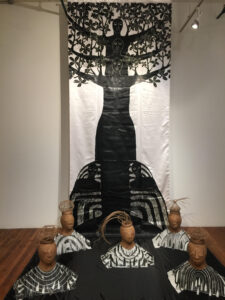
Yoruba Gaze Installation
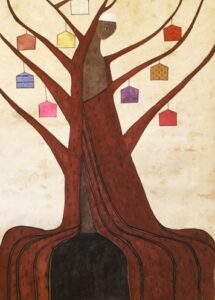
Iroko in the House of the Orishas
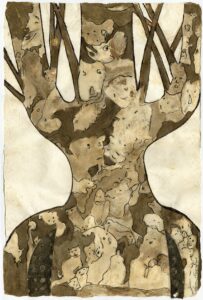
Baobab Tree of Life of Africa
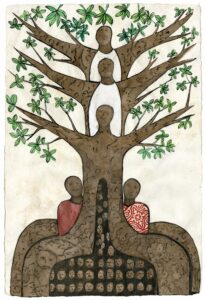
Odudua Obbatala Chango Agayu Sola
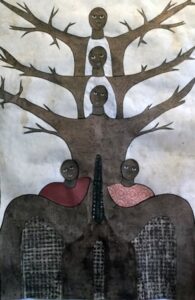
Yoruba Sacred Tree in the Antilles
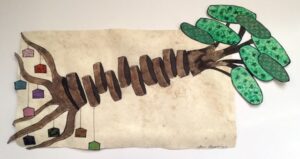
Transcendental Ceiba
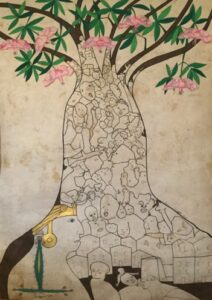
Yaxche Sacred Tree of Maya
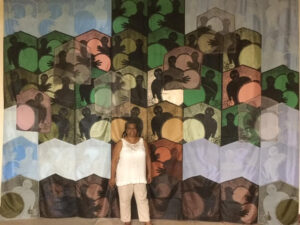
The artist in front of the giant print IROKO Tree of Life, Amate paper, clay sculptures, relief print tapestries and handmade paper with encaustic, reed fiber woven sculptures with the multi-media video.
The artist describes IROKO: TREE OF LIFE:
IROKO was inspired by the sacred Tree of Life, known as Iroko to the Yoruba people of West Africa and those of the African Diaspora, Yaxché to the Maya, Kapok in Southeast Asia, Silk- Cotton Tree to Indigenous North Americans, and La Ceiba in the Caribbean, Central and South America. The tree is of great symbolic, spiritual, mythological, medicinal, magical, commercial, ecological and aesthetic import. Through the exploration of materials old and new, traditional and innovative technologies this multi-media installation focuses on the mysteries of nature using the Iroko/ Yaxché/ Kapok/ La Ceiba / Silk-Cotton Tree as an anchor to express the power of nature, its continuity and resiliency which hold the promise for a sustainable future if nurtured and honored.
Arroyo worked in collaboration with graphic and digital media artist, Tao Chen, and video producer, Jaime Gomez. on a video accompanying the huge print
In the video, filmed by Julio Charris, Jaime Gomez interviews the Katanzama Indigenous people of Columbia. It also includes a dance choreographed by Alycia and performed by Sinque Tavares. The music includes traditional Yoruba Orisha songs sung by Amma McKen, Iya Ola and Swahili Henry and a new dance performed Bright-Holland.
Bringing together many voices in the video, as well as the large print, profoundly speaks to our interconnections. As the artist eloquently explains:
IROKO addresses the challenge of climate change by exploring the interrelationship between our external ecological situation, our awareness of the sacred in creation, and our internal relationship with the symbolic world of the soul. IROKO’s intention is to promote art that expresses that complex, diverse and dynamic intersection, while seeking to connect the intellectual, spiritual and practical components of community building and sustainability.*
A part of the “Iroko Tree of Life” joined an exhibition at the ChShaMa exhibition space called AfreeCan in April and May 2021 in New York City.
Prayer for a Warrior Island
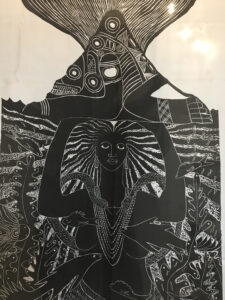
Currently, September 2021, at the Museum of the Americas in Puerto Rico Arroyo contributed Plegaria para una isla guerrera Prayer for a Warrior Island organized by Las Jornadas del Grabado Puertorriqueño. It was carried in a protest in Puerto Rico.
This print pays tribute to the ancestors of the valiant Taino Indigenous people and the African warriors whose legacy continues to empower their dependents to defend the island from the colonial pirates, imperialists conquistadors, opportunities, embassies, rogues and liars.
We can all immerse ourselves in Imna Arroyo’s extraordinary art works that fuse spirituality, art and nature, with specific resferences based on her own varied experiences. Her carefully thought out prints and multimedia installations can provide us with new hope and perspectives in our present state of climate catastrophe.
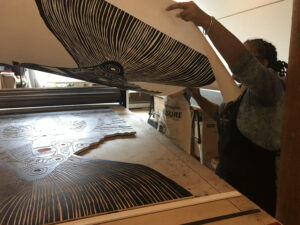

Part 3 The Future!
Imna Arroyo: Travesías / Crossings is the title of Imna Arroyo’s current project. It will be a major retrospective, focusing on her interpretation through her art of displacement and migratory flows. Co-curated by Humberto Figueroa from Puerto Rico and Benjamin Ortiz of Connecticut with Yolanda Wood, a cultural critic based in Cuba and visiting professor at the Universidad Nacional Autónoma de México. Project , it will be seen at 3 venues: Museo de las Americas, La Casa del Libro in San Juan, in Puerto Rico and Caribbean Cultural Center African Diaspora Institute in Harlem, New York.
———————————–
All quotes from Imna Arroyo based on our email correspondence, August, September 2021.
*IROKO TREE OF LIFE, Ancestral imprint, the Yoruba Cultural Association from Cuba, 2017. It features essays by ecologist, Carmen R. Cid, art historian, Maline Werness-Rude, and writers Isis Mattei, Maria Vazquez, Esperanza Cáseres Santa Cruz, Jaime Gómez, Migdalia Salas and Humberto Figueroa. The exhibition opened in 2017 at the Connecticut the Clear Gallery, Charter Oak Cultural Center in Hartford and MS 17 Art Gallery in New London.
This entry was posted on September 8, 2021 and is filed under Art and Activism, ecology, Feminism, Uncategorized.

